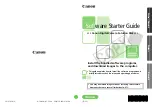
117
Streamlining output with PDF presets
To output PDF files with a minimum of time and work, take advantage of the PDF export
presets feature. With PDF export presets, job settings are easy to standardize with minimum
potential for operator error.
Set up workflow-specific PDF export presets on the computers in your shop before starting
to handle customer files. You can then apply a PDF export preset to a customer file and most
or all of the options specific to your configuration will be applied instantly. In many cases,
the only options you’ll have to change are the ones specific to the job. You can save time and
decrease operator error by creating a PDF export preset in advance for each workflow you
regularly use in your shop.
About the predefined PDF export presets
Adobe InDesign CS includes pre-defined PDF export presets. Note that for prepress service
providers, Press is the preset that should typically be used, but many organizations are now
standardizing around PDF/X-1a and PDF/X-3. These ISO standards should be of particular
interest to prepress service providers because they are specifically designed to increase the
reliability of PDF-based prepress workflows. The following PDF export presets are built into
Adobe InDesign CS:
•
eBook.
Creates Adobe PDF files that will be read primarily on screen—on desktop or laptop
computers or eBook readers, for example. This set of options balances file size against image
resolution to produce a relatively small self-contained file. All color spaces are converted to
RGB; color and grayscale images above 225 dpi are downsampled to 150 dpi, and mono-
chrome images above 450 dpi to 300 dpi; subsets of all fonts used in the file (except the base
14) are embedded; and all information is compressed. Adobe PDF files created using the
eBook PDF preset are compatible with Acrobat 5 or 6.
•
Screen.
Creates compact Adobe PDF files that will be displayed on the World Wide Web or
an intranet, or that will be distributed through an email system for on-screen viewing. This
set of options attempts to create as small a document as possible. It compresses and down-
samples to monitor resolution; converts all colors to RGB; maintains compatibility back to
Acrobat 4; and embeds subsets of all fonts used in the file except the Base 14 fonts (which are
not embedded). It also optimizes files for byte serving.
•
Print.
Creates Adobe PDF files that are intended for desktop printers, digital copiers, pub-
lishing on a CD-ROM, or to send to a client as a publishing proof. In this set of options, file
size is still important, but it is not the only objective. This set of options uses compression
and downsampling to keep the file size down, but it also embeds subsets of all fonts used in
the file. The transparency flattener is set to Medium Resolution.



































